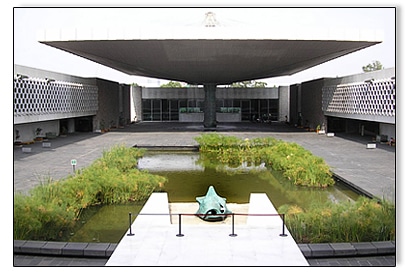“…As long as the world exists,
the glory and honor
of México Tenochitlán
must not be forgotten.“
Chimalpahín Quauhtlehuatzin
Neither conquest nor time, nor new foreign influences have been able to erase from the Mexican memory, the splendor of its pre-Hispanic past. Even before Mexico had achieved independence, there was already an awareness of its valuable heritage and the need for it to be known by Mexicans themselves as well as by foreigners.
Aztec, Mayas Zapotec, Mixtec, Purépecha, Olmec and many other cultures are still alive in Mexico today.
As a tribute to all of them, the National Museum of Anthropology and History was inaugurated on September 17, 1964, located on Paseo de la Reforma Avenue, in the second section of the legendary Chapultepec Park
Chapultepec Park is a veritable festival of the people on Sundays. Families wander along its paths, in the midst of food stands, balloon vendors, photographers’ and caricaturists’ stands, and all the other people who come to this fabled place to pass a pleasant afternoon.
For parents who like to combine fun with culture, nothing is better than the many museums found in Chapultepec Park. After a day in the country, or a visit to the traditional zoo, families scatter off toward their favorite museum.
One of the most traditional, since its inauguration in September, 1964, is the National Museum of Anthropology and History.
At the entrance is an imposing statue of Tlaloc, the Aztec god of rain. They say that on the day it was brought to its current location, an unforgettable, torrential rain fell on Mexico City…
It was built by the Mexican architect, Pedro Ramírez Vázquez, over a period of 19 months.
One of the museum’s main features is that its use of open spaces is exemplary. The museum covers an area of 79,700 square meters, 35,700 of which are in the open air! (the central patio, the entrance square, and several other patios). The show rooms surround the central patio. Each room is dedicated to a particular culture, beginning with the origins of man and encompassing the Toltecs, the Teotihuacans, the Mayas, and in particular, the Aztecs.
A trip through the rooms, entering and leaving them through the patio, gives one a feeling of coolness and lightness; in contrast to so many dismal museums, this one manages to really impress the visitor without tiring him or her.
Being in this museum is truly a moving, and at the same time motivating, experience. Here, pieces that witnessed greatness and wisdom share the space with works of art created by our ancestors many centuries ago.
Besides its restrained beauty, the museum’s architectural structure uses very interesting symbolism. For example, the bronze snail in the pond found in the main patio represents the way the ancient Mexicans called each other together: by rattling the sea snail shells whose sound still makes us tingle in remembrance of those civilizations.
The complex in general is very similar to Mayan constructions, with the first body of smooth stone and the upper one covered with geometrical bas reliefs.[1]
The inverted fountain, also located in the central patio, is a marvelous sculpture that records on its metal column, the two races who merged, the Indigenous and the Spanish, to create a new nation. And around this pillar a circular curtain of rain falls gently, endowing the whole place with a fresh coolness and solemnity. Although I have to say that it is also one of the favorite places of the children who visit the museum, who play at getting as close as they can to see who gets wet!
If you cross this light curtain of water, you will hear only the sound of water falling and, very, very far away, the music of a flute. This is the echo of the ritual performed daily by the “Papantla flyers” in a clearing of the woods in front of the museum.


